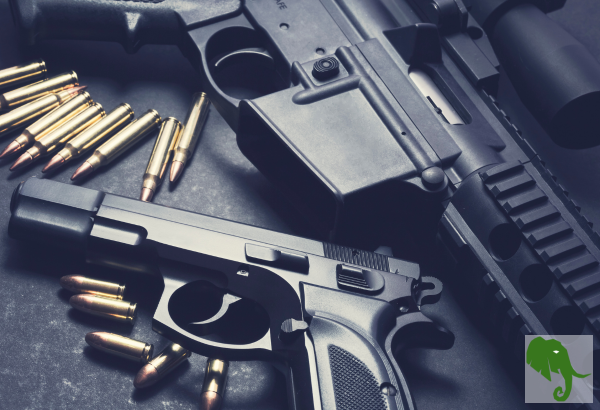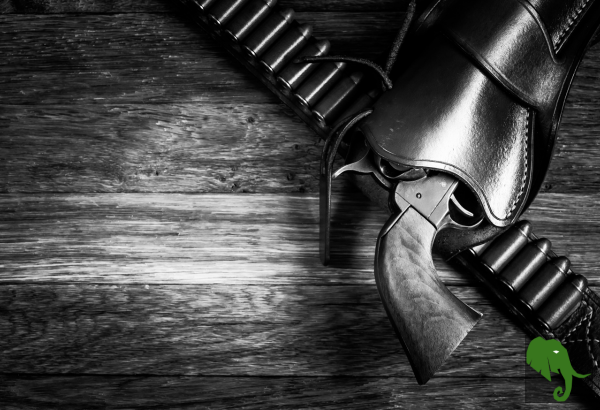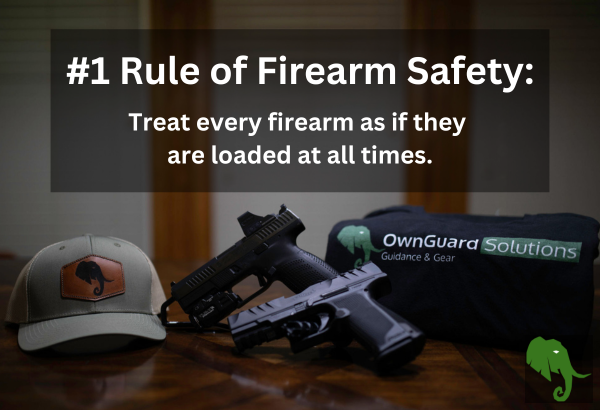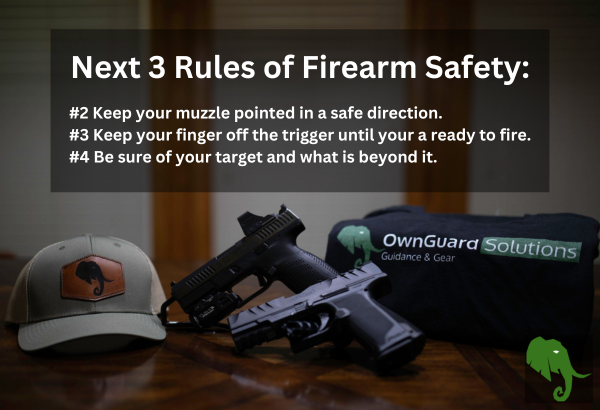
As gun owners (or even just handlers of firearms), we have many responsibilities. The reality of lawful gun ownership and handling is that it is not just a right but a privilege. Not everyone gets to handle firearms, much less own them lawfully. Following basic gun safety rules is just one of the many responsibilities we have. I try to list the things we all need to ensure we are doing or the things some of us need to be doing better as responsible gun owners (and handlers).
Practicing Gun Safety
If you are not at all familiar with at least the four fundamental gun safety rules, I have included them here. Of course, there are other safety-related things you also need to know and be practicing. We try to cover several of them here to help people be more responsible gun owners.
The 4 Fundamental Gun Safety Rules
- Treat all guns as if they are loaded at all times.
- Never point the muzzle of a firearm at anything you are not willing to destroy.
- Keep your finger off the trigger (and out of the trigger guard) until your sights are on target and you are ready to shoot.
- Be aware of your target, what is behind it and anything around it.
Gun Shop
Follow good safety protocols (or etiquette) at the gun store when you go, including:
- Double checking any firearm that gets handed to you from behind the counter to make sure it is clear, even if you just saw them clear it before you. (Some do not.)
- Checking that same firearm again before handing it back to any personnel behind the counter.
- Being careful not to point the muzzle of any firearm in the gun store at anyone else.
- Not taking out any of your personal firearms in a store unless given permission.
- The basic rule is to always follow the fundamental 4 gun safety rules when handling any firearm.
Gun Range
Here are some specific safety rules or precautions to take while on a gun range:
- Following any specific safety rules for a given range, as many have their own list. These may include but will also be in addition to the fundamental gun safety rules.
- When you are shooting you should be following the fundamental gun safety rules at all times.
- Keep check on or look around you regularly while you shoot, to give yourself a better chance of avoiding a bad situation. Do not just stay up in your lane and be oblivious.
- Don’t be shy about calling someone out for unsafe gun handling in a polite manner. If you are not comfortable doing so for whatever the reason, go let range/gun store staff know so they can deal with it directly.
- Call a cease fire if you witness an unsafe situation on the range. Usually, anyone has the power to call a cease fire if they are the one to witness a situation.
Handling of Toy or Trainer Guns
The short? Treat them like a real firearm at all times. It just sets and re-enforces the precedent.
For examples, you can take the opportunity to teach your kids good gun handling habits with toy guns; and with trainers, like the plastic/rubber ones or the SIRT pistols, instructors should be requiring themselves and their students to handle them with the same respect by following the fundamental gun safety rules at all times like the real thing. Of course, some training firearms actually shoot projectiles, so you need to be following proper safe handling protocols when those types of trainers are in use anyway.
While the above does not cover every safety rule or protocol, like rules when hunting, it is a very good start for those wanting to shoot and find themselves in a gun store or at a range. And if you see redundancies, it is by design.
If you simply don’t follow gun safety rules, are not concerned about safety, believe you are above needing to abide by gun safety, you ‘know’ your firearm is ‘unloaded’ so the safety rules no longer apply for you and your ‘unloaded’ firearm, or you believe the gun safety rules are overly restrictive, then you may want to reconsider firearm ownership. Harsh? Nope. You know who you are.
And if you’re new, just ask someone. A lot of folks in the gun community are willing to have the conversations with you and help you out as they can. Of course, you can always get some training; and we talk more about that coming up.
Keeping Our Firearms Clean
While it is technically a safety-related item, I pulled out the fact that we need to keep your firearms clean as its own item here in the list. Cleaning a firearm is safety-related because keeping your firearms clean goes a long way towards keeping them in good working order.
I am not going to tell you they need to be cleaned after every time you shoot; but if you can find the time, it is not a bad idea. Most modern firearms can go many, many, many rounds fired before needing a bath. Mileage will vary and there will get to be a point where performance becomes an issue even if it is subtle. So the short is to keep them clean and protected.
Even when your firearms find themselves becoming “safe queens,” like many do, you should pull them out from time to time and give them a once-over and clean them up if they seem gummed up or are super dusty. You’ll feel better and they’ll rest easier while they are in that safe, which is where you should be keeping them anyway when they are not in use. We talk more about that next, in fact.
Securely Storing Our Guns
Anytime a firearm is not in your direct control, you have other people in your home, or you are away from home for periods of time, your firearms should all be locked up, whether in a gun safe, a lockbox, or via a simple padlock, like the ones that may have come with your firearms.
Second to locking them up is being very careful about who you might grant access to those locked up firearms. The fewer the better. With active shooter events and suicides by firearm being big concerns, keeping our firearms locked up is definitely a way we can all be more responsible gun owners.
If you have firearms for home or family protection and you are keeping them locked up, like you generally should, you need to practice getting to them and efficiently getting them out of their locked storage locations. Yes, keeping them locked up will slow things down a bit when you need to get to them; but this is why you practice. Keeping them secured is the most important aspect, as bad things rarely happen in the overall scheme of things. A trade off but a worthwhile one if you have others in your house, especially children, or if you are gone frequently.
Shooting Regularly
Yes, go shoot; and shoot regularly, at bare minimum, once a month or more if you have a firearm for defensive purposes. You likely already shoot regularly if you shoot competitively. No matter. If you have a gun, you need to shoot it, unless of course you got it purely for feel good purposes or desktop decoration, in which case you still need to keep it locked up.
And so you understand too, shooting is a depreciating skill. Gotta use it or loose it, over time. So – Go shoot!
Of course, maybe you need some training to feel comfortable, to understand safe handling, or just to become a better shooter.
Training
Some argue that you do not need training in order to shoot a gun. After all, it is fairly straight-forward to read the owner’s manual or watch a video these days, in order to learn how to load a firearm (once you know what caliber it shoots), point it at the thing you are wanting to shoot, and just pull the trigger. Voilà! You just shot a firearm. That bar was pretty low.
Obviously, that is an extremely simplified overview and our bar for shooting should be higher than that; but to the point that training is not absolutely needed in order to just shoot a firearm, in the most basic sense, I would have to agree. And with the proliferation of how-to videos, it makes it all the easier. However, I feel strongly like getting proper training goes a long way towards making us all more responsible gun owners.
Why No Training
I feel like the majority of people that shoot, whether it be with their own firearm, a rental, or their buddy’s when they go to the range together, follow similar practices. It seems to me that most folks do not seek out formal training; and it shows. Everything from how they hold their guns, to how inaccurately they shoot, to how unsafe many handle those firearms, not thinking once about where their muzzle is pointed or the fact that their finger is constantly on the trigger, as examples.
I am not saying that there is not anyone seeking training at all, because they are and they do; but by and large, I believe it is not the majority. Anytime I am at the range, I would bet most folks there have not gotten training, because again, it shows.
In fairness, sometimes I think it is just a money thing or maybe it is because people figure they shoot so little that training just does not make sense for them. Hopefully, they will come around to realize there is still a place in training for them.
Why Train
When I talk about the need for training, I hope it is obvious that I am wanting to encourage people to get the training and support their need to shoot the way they want to. Here are some reasons to consider more formal training. You:
- Want to learn the basics in order to become a better shot and be safer doing it; or maybe you understand that a strong foundation in the basics will allow you to go onto more advanced types of shooting and training.
- Can admit you actually do not have it all figured out yet and you don’t know everything.
- Are intimidated by handling a firearm, its sound, or managing its recoil.
- Have never shot before and have an interest; but just feel like you would do better with some support present.
- Are not well versed in the gun safety rules and what they mean; but you recognize that firearms need to be treated with respect and handled safely and you want to.
- Are wanting to learn to shoot more accurately and consistently because you have an interest in competitive shooting of some type.
- Purchased a firearm for self-defense or family protection, you recognize these purposes go well beyond just the basics.
- Are just starting out and know nothing or maybe you have decided to get back to shooting after a lengthy break and you want to go about it properly.
- ?
Any of the above reasons and more are solid reasons to seek out training to help you achieve your objectives when you handle a firearm and shoot. Can you think of others? Leave them in the comments below.
Indirect Outcomes of Training
I also want to mention indirect but worthwhile outcomes of training. Training can also change an unhealthy attitude towards firearms. Individuals going through training might gain respect for firearms and start handling them with more respect with safety are the top of their priorities. Of course, in training, they might could also decide firearms are not right for them, which is perfectly OK too. Both are responsible decisions.
Knowledge to be Gained
When I think of training, at least training in the foundational parts of shooting and handing a firearm, I am talking about things like:
- Gun safety rules and what they mean.
- Terminology to support a common language for knowledge sharing.
- Proper shooting stance.
- How to properly hold a pistol, not tea-cupping it or placing your thumb behind the slide of a semi-automatic pistol, as examples.
- How to correctly aim, i.e. sight alignment, sight picture, front sight focus, target focus, knowing your dominant eye, using both eyes, etc.
- How to correctly press the trigger and follow-through.
- Etc.
On and on and on. Sure, someone could learn what most of these things are on their own; but are they doing it? I am going to go out on a limb again here and say, “No, they are not.” This is based on what Denis and I have both seen on a range working as RSOs, as well as what I regularly see on just about any trip I take to the range to shoot. This is including two weekends ago when I had yet another individual point his pistol right at me!
Of course, there are also various types of advanced training we can take advantage of just so we can continue improving. Learning should be a never ending activity. However, starting with the basics, the foundational pieces, is a great first step and really helps set us up for success whatever the path we choose. If you are wanting to do advanced training, you’ll likely have to complete some basic beforehand. You have to learn how to crawl before you can run.
The Decision to Get Training
If someone has decided they need or want to get training; and are willing to pay for it, then there is a pretty good chance they are going to take it seriously, listen with an open-mind, and have a willingness to learn. They know they have a better chance of learning if they have made the commitment to get the formal training. Making the decision to get some training and following through goes a long ways towards making us responsible gun owners.
Some Questions to Ask Yourself
How do I know what to do or how to do it correctly if I have not done it before or have not been shown? Do I have a firearm for defensive purposes? Am I planning to carry for self-defense? Can I draw efficiently? Do I consistently and repetitively hit what I am aiming at? Am I capable of effectively shooting under stress or pressure of some type? Do I dry fire regularly? How quickly can I get to my staged firearm for home protection? Have folks corrected me more than once for some sort of safety violation? These are the sorts of questions you should be asking yourself to uncover the fact that you may actually need more training or practice.
Becoming Familiar with Laws
Know the laws in your state. Not everyone is a lawyer; and we do not need to be. However, as responsible gun owners, especially if we carry for defensive purposes, we should become at least somewhat familiar with the laws that directly impact how and where we can carry; and most importantly, when and when we cannot use a firearm in a defensive manner. You should learn:
- How the law views your vehicles, as compared to other property you own like your home.
- Whether you are allowed to open carry or not.
- How you need to carry firearms in your vehicle when you have a concealed carry permit versus when you do not.
- How the laws differ in states you may travel to.
- How a court and jury are going to weigh any case you may find yourself caught up in.
- What steps should you take immediately following an event you may find yourself in, including what you should and should not say or do.
- And more…
Laws can be tedious to the layperson; but it will help you be more informed. Remember, ignorance of the law does not excuse you from the law.
Dealing with Anti-Gunners and Gun Control Advocates
The most succinct way I can say this is that we all need to be good stewards as responsible gun owners. Here are some ways we can all do that:
- Look for opportunities to impact or change someone’s views. Of course, you don’t have to go out of your way; but you may want to take advantage of an opportunity that presents itself.
- Suggest accurate information or correct data points, if you know them, anytime you hear info you know is not entirely on point and reference resources where you can.
- Talk about all the good things that happen that do not necessarily make it into the news.
- Speak respectfully and keep the discussion above board, no name calling, etc. If it gets heated, acknowledge it and walk away. If you also figure out the other party is not really interested in dialog or hearing a different perspective, walk away.
- Thank them for their views and time no matter the outcome.
Recognizing Guns Are Not Go-To or Magical Tools
If you have a firearm for self-defense or family protection, then you need to recognize that a gun:
- Is not going to keep you out of trouble or get you out of all trouble.
- Is not supposed to be a go-to tool and in fact should be viewed only as a last resort. Firearms should not be your first choice in a bad situation if you can avoid it.
- Is not a cause to go looking for trouble. In fact, firearms need to be a cause to further avoid it.
In other words, any woes you may have had are not just going to end because you suddenly keep or carry a firearm for protection. Softer skills, like situational awareness, behavioral awareness, avoidance, verbal de-escalation skills, listening to your intuition, etc. should still take priority in your arsenal. Not as sexy or not a part of that fantasy of how things might happen? No, likely not; but these soft skills will likely keep you safer by allowing you to get out of or even avoid the trouble to begin with. That’s where the real priority should be. And ironically, being better at these soft skills goes a long way towards makings us more responsible gun owners.
And no, you cannot just shoot someone and claim, “I feared for my life.” It does not work that way. Another fantasy busted, I know.
Stop Believing Everything You See on TV and in Movies
In my estimation, the majority of gun handling, as portrayed on TV shows and in the movies, is at best not accurate; and worst case, is depicting unsafe handling the majority of the time. How many times, for one example, have you seen someone with their finger on the trigger when they were not actually firing the gun?! I have lost count!
How many actors have been hurt or killed by unsafe firearm handling? How many have hurt someone else and then blamed the ‘gun handler’ for it? Little do they understand, nor are they held accountable to them also being a ‘gun handler’ the moment they pick one up. I digress. The point is we are fed a lot of bad information when it comes to firearms and handling them safely or what is accepted as being safe.
Who’s to Blame?
I have no data to support this; but I believe TV and movies (and video games) are at least in part responsible for causing most of the misconceptions about guns and the proper, safe handling thereof. Some people fantasize about what they could do with a firearm if something bad happened to them as well as what they are capable of while using one.
The fantasy of being able to use a firearm in a certain way or in particular scenarios have been driven by the entertainment we have watched most of our lives. That and the lack of any formal training sets folks up to be way out of touch with reality. And too, they simply do not shoot enough to know any better or to improve any.
Get some training and stop getting your information from TV, the movies and the video games. Keep your ego in check. Be open to and have the willingness to learn new things. Be open to input or correction when someone else sees you not handling a firearm the way you should, as an example. Choosing to live in ignorance or in a fantasy is not a virtue nor is it part of being responsible gun owners. The land of make-believe is not entirely based in reality.
Conclusion
Gun ownership and handling of firearms comes with a lot of responsibilities, as it should. It is serious business; but that’s not to say that we cannot be responsible gun owners while still enjoying the activities, having fun, and learning as we go.
I enjoy watching others shoot at the range, enjoying the activity the way I do, especially when someone new(er) shoots very well for just starting out. It is great watching them have fun and enjoy the activity of shooting. I also want them to prioritize safety while they handle their firearms as well as to take the steps to become more proficient. The only way to do that is through shooting regularly and getting the training.
Can you think of anything that we did not cover in this post that you would like to add? Leave them in the comments below.
It is my hope this post gave you some food for thought if nothing else.
Safe shooting.
Related Content

Holsters Enhance Pistol Carry Safety
If you are carrying a pistol for defensive purposes, on- or off-body, that pistol generally needs to be in a holster, especially when it is…

Inaugural Episode: Mastering Gun Safety with Expert Insights, Part 1
Overview Season 1: Episode 1, Part 1 Welcome to the first episode of the Self-Initiative Project podcast, hosted by Jim O’Brien. In this episode,

Mastering Gun Safety with Expert Insights, Part 2
Overview Season 1: Episode 2 Finally… Jim reunites Denis in this episode to finally wrap up their discussion on gun safety. After nearly a year since…

Read other OwnGuard Solutions blog posts
Read our other posts centered around being safer and better prepared.

